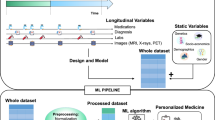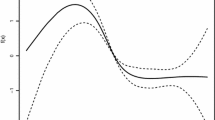Abstract
Recurrent event data frequently occur in many longitudinal studies, and the observation on recurrent events could be stopped by a terminal event such as death. This paper considers joint modeling and analysis of recurrent event and terminal event data through a common subject-specific frailty, in which the proportional intensity model is used for modeling the recurrent event process and the additive hazards model is used for modeling the terminal event time. Estimating equation approaches are developed for parameter estimation and asymptotic properties of the resulting estimators are established. In addition, some procedures are presented for model checking. The finite sample behavior of the proposed estimators is evaluated through simulation studies, and an application to a heart failure study is provided.
Similar content being viewed by others
References
Huang C Y and Wang M C, Joint modeling and estimation of recurrent event processes and failure time, J. Amer. Statist. Assoc., 2004, 99: 1153–1165.
Liu L, Wolfe R A, and Huang X, Shared frailty models for recurrent events and a terminal event, Biometrics, 2004, 60: 747–756.
Ye Y, Kalbfleisch J D, and Schaubel D E, Semiparametric analysis of correlated recurrent and terminal events, Biometrics, 2007, 63: 78–87.
Zeng D and Lin D Y, Semiparametric transformation models with random effects for joint analysis of recurrent and terminal events, Biometrics, 2009, 65: 746–752.
Cook R J and Lawless J F, Marginal analysis of recurrent events and a terminating event, Stat. Med., 1997, 16: 911–924.
Ghosh D and Lin D Y, Nonparametric analysis of recurrent events and death, Biometrics, 2000, 56: 554–562.
Ghosh D and Lin D Y, Marginal regression models for recurrent and terminal events, Statist. Sinica, 2002, 12: 663–688.
Miloslavsky M, Keles S, Van der Laan M J, et al., Recurrent events analysis in the presence of time-dependent covariates and dependent censoring, J. R. Statist. Soc. B, 2004, 66: 239–257.
Cook R J, Lawless J F, Lakhal C L, et al., Robust estimation of mean functions and treatment effects for recurrent events under event-dependent censoring and termination: Application to skeletal complications in cancer metastatic to bone, J. Amer. Statist. Assoc., 2009, 104: 60–75.
Zeng D. and Cai J, Semiparametric additive rate model for recurrent events with informative terminal event, Biometrika, 2010, 97: 699–712.
Lin D Y and Ying Z, Semiparametric analysis of the additive risk model, Biometrika, 1994, 81: 61–71.
Breslow N E and Day N E, Statistical Models in Cancer Research 2: The Design and Analysis of Cohort Studies, International Agency for Research on Cancer, Lyon, 1987.
Wang M C, Qin J, and Chiang C T, Analyzing recurrent event data with informative censoring, J. Amer. Statist. Assoc., 2001, 96: 1057–1065.
Liang K Y and Zeger S L, Longitudinal data analysis using generalized linear models, Biometrika, 1986, 73: 13–22.
Sun J, Sun L, and Liu D, Regression analysis of longitudinal data in the presence of informative observation and censoring times, J. Amer. Statist. Assoc., 2007, 102: 1397–1406.
Lin D Y, Wei L J, Yang I, et al., Semiparametric regression for the mean and rate function of recurrent events, J. R. Statist. Soc. B, 2000, 69: 711–730.
Lin D Y, Wei L J, and Ying Z, Checking the Cox model with cumulative sums of martingalebiased residuals, Biometrika, 1993, 85: 605–619.
Che X Y and Angus J, A new joint model of recurrent event data with the additive hazards model for the terminal event time, Metrika, 2016, 79: 763–787.
Jin Z, Lin D Y, Wei L J, et al., Rank-based inference for the accelerated failure time model, Biometrika, 2003, 90: 341–353.
Chen K, Jin Z, and Ying Z, Semiparametric analysis of transformation models with censored data, Biometrika, 2002, 89: 659–668.
Zeng D and Lin D Y, Efficient estimation of semiparametric transformation models for counting processes, Biometrika, 2006, 93: 627–640.
Huang C Y, Qin J, and Wang M C, Semiparametric analysis for recurrent event data with timedependent covariates and informative censoring, Biometrics, 2010, 66: 39–49.
Zhao X, Zhou J, and Sun L, Semiparametric transformation models with time-varying coefficients for recurrent and terminal events, Biometrics, 2012, 67: 404–414.
Lin D Y, Wei L J, and Ying Z, Semiparametric transformation models for point processes, J. Amer. Statist. Assoc., 2001, 96: 620–628.
Lin D Y and Ying Z, Semiparametric and nonparametric regression analysis of longitudinal data, J. Amer. Statist. Assoc., 2001, 96: 103–126.
Pollard D, Empirical Processes: Theory and Applications, CA: Institute of Mathematical Statistics, Hayward, 1990.
van der Vaart AW and Wellner J A, Weak Convergence and Empirical Processes, Springer-Verlag, New York, 1996.
Author information
Authors and Affiliations
Corresponding author
Additional information
YE’s work was supported by the National Natural Science Foundation of China under Grant No. 11601080 and “the Fundamental Research Funds for the Central Universities” in UIBE under Grant No. 15QD16; DAI’s work was supported by the National Natural Science Foundation of China under Grant No. 11361015.
This paper was recommended for publication by Editor YU Zhangsheng.
Rights and permissions
About this article
Cite this article
Ye, P., Dai, J. & Zhu, J. Joint analysis of recurrent event data with a dependent terminal event. J Syst Sci Complex 30, 1443–1458 (2017). https://doi.org/10.1007/s11424-017-6097-5
Received:
Revised:
Published:
Issue Date:
DOI: https://doi.org/10.1007/s11424-017-6097-5




